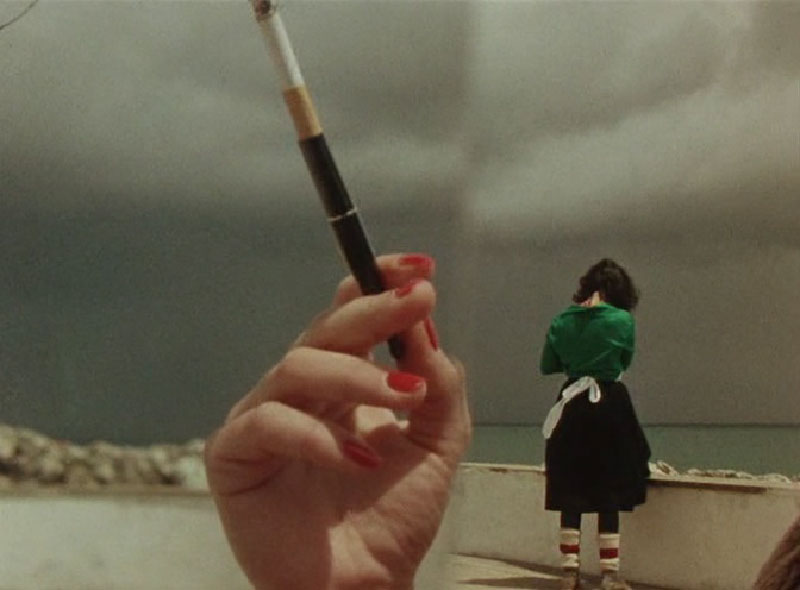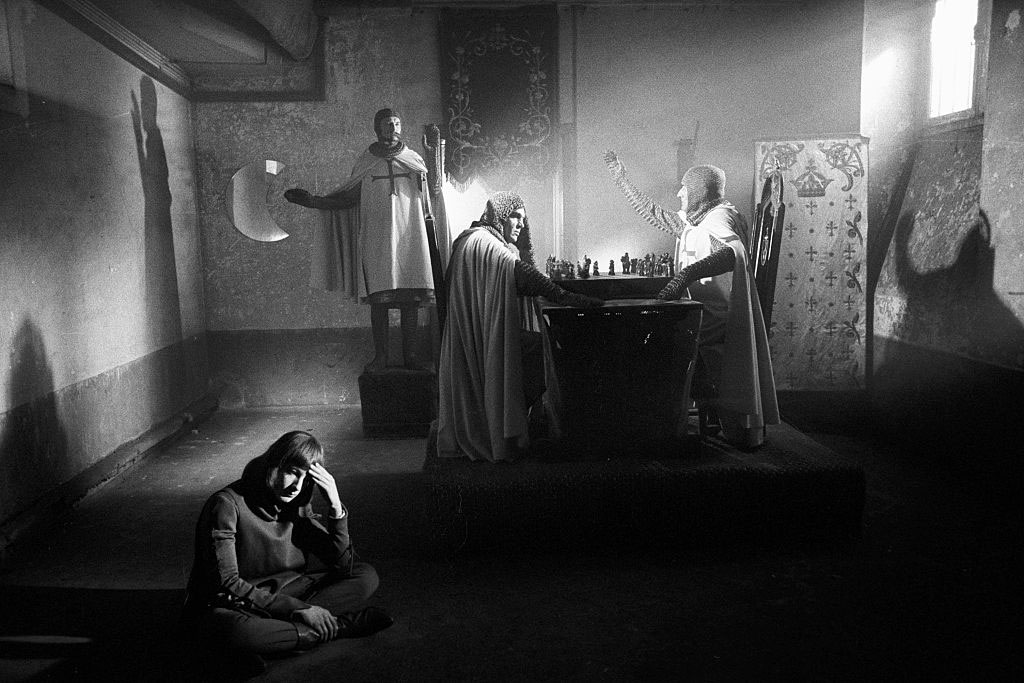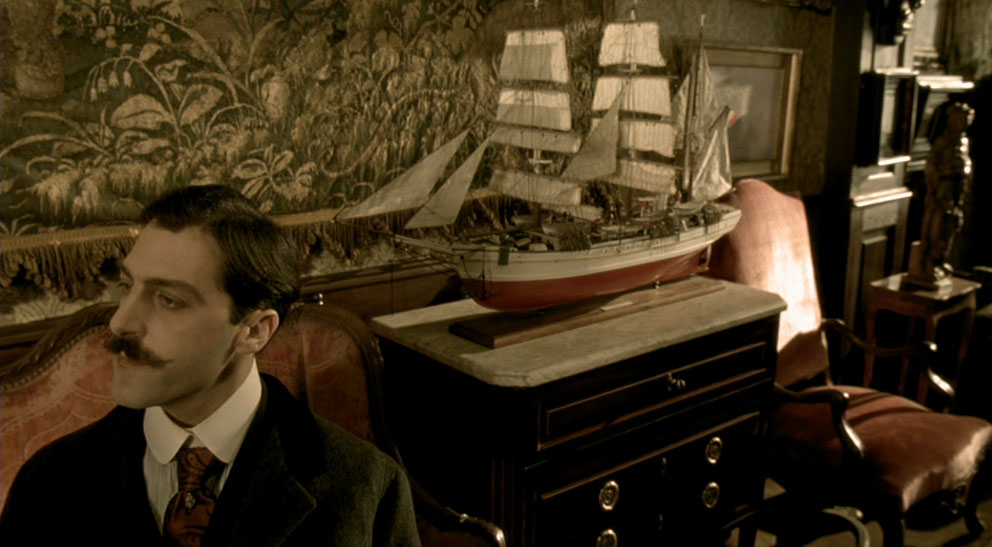One way of beginning to love the work of the filmmaker Raúl Ruiz is to do some gentle arithmetic. Ruiz, who was born in Chile in 1941, made more than one hundred films (100!)—in a career that ran from 1968, when he made his first feature, Three Sad Tigers (a neo-realist portrait of Santiago’s dealers and hustlers), to 2012, when his wife Valeria Sarmiento completed his last movie, Lines of Wellington (a tender fresco of the Peninsular War) the year after he died. An average year for Ruiz, therefore, involved making two or three movies—as well as the business of living. And one way of interpreting this monstrous output is to consider a single fact of his biography: shortly after Augusto Pinochet, backed by the US, took power in Chile in a coup on 11 September 1973, Ruiz fled across the Atlantic to Paris. He was thirty-two.
Ruiz’s career can be understood as a sustained resistance, a manic guerrilla operation, against two forms of power: the violence of Pinochet’s dictatorship, and the control on conventional movie-making exerted by Hollywood. He is the exile director: a Latin American who made most of his movies in English, French, or Portuguese—and whose aesthetic inhabits an absolute alien territory. His films are drifting, fantastical, introspective, melancholy, erudite, raucous—sometimes telling no story at all, sometimes telling too many. He made so many films, and they so consistently refuse to obey whatever formal rules we’ve come to expect from cinema, that they tend to develop into a blurry whole in your mind. Ruiz’s films form a climate more than a series of individual works.
It all means that a retrospective is as impossible as it’s welcome. “Life is a Dream,” the first installment of a planned three-part survey of Ruiz, just closed at the Lincoln Center in New York—and its films provided the dazzled spectator with vast material for future speculation. They roughly clustered into small bursts of energy: the late Seventies, beginning with Dialogues of the Exiles in 1975, then The Suspended Vocation and The Hypothesis of the Stolen Painting from 1978; the early Eighties, when Ruiz expanded his B-movie, dreamlike mode, including The Territory from 1981 and then Three Crowns of the Sailor, City of Pirates, and Bérénice, an adaptation of Racine, all from 1983; the late Nineties, when he placed European arthouse stars (Marcello Mastroianni, Catherine Deneuve) inside lushly drifting tales: Three Lives and Only One Death in 1996, Genealogies of a Crime in 1997, Time Regained in 1999, and Love Torn in a Dream in 2000; and then the final years where, in La Recta Provincia from 2007, Mysteries of Lisbon from 2010, and Lines of Wellington in 2012, Ruiz examined social and historical panoramas at lavish length.
And there are still around eighty-five movies missing! Even the title of the program, Life is a Dream, is taken from a film that wasn’t included in the initial selection—but I understand the urge to steal it. The film is based on Pedro Calderón’s seventeenth-century play, where various levels of reality—mystical and metafictional—are elements in a cosmic game. For Calderón the studio for this cosmic examination was a theater, for Ruiz it was a cinema. Still, the play with the real was the same.
The basic rule, in a Ruiz movie, is that different stories co-exist, either nested within one another or side by side. Perhaps the most exuberant example of this is Three Crowns of the Sailor, from 1983. It begins with a student who has just murdered his professor in Warsaw. Fleeing through the streets at night, he meets a sailor, who offers him a way out of the country on a boat. In a bar, the sailor names his price: that the student must listen to the story of his adventures, and pay him three crowns. The film then tells the picaresque story of the sailor’s adventures on board the Fuchalense, a ghost ship docking around the world—so that the movie’s structure resembles the great story novels, like Jan Potocki’s The Manuscript Found at Saragossa, jumping from Maria, a virginal-seeming prostitute whose room is a museum of dolls and coffins, to a street fight in Tangiers, to an abandoned boy in Singapore, to more miniature unrealities—a ship sinks only to reappear in another harbor, a man jumps overboard only to reappear on deck the next day. And all these stories are told in a kind of cheap, headlong aesthetic: the sets are cluttered with dolls and other surrealist totems that suddenly loom in the foreground of a shot, while the apparent plot continues to unfold, out of focus; and the camera angles are restlessly varied, from vertiginous aerial shots to furtive ground-based viewpoints.
It’s as if Ruiz was always impatient at the basic cinematic techniques. Watching these movies, I was struck by the recurrence of a strange motif: the tableau vivant—where the figures in a painting are recreated by living models. The tableau vivant forms the plot structure of The Hypothesis of the Stolen Painting, and then appears elsewhere, in Genealogies of a Crime, and Time Regained. And its use, I think, relates to Ruiz’s antic investigation into the tyranny of camera angles. There’s an essay by Pier Paolo Pasolini, called “Observations on the Long Take,” where Pasolini points out that in a movie it’s
impossible to perceive reality as it happens if not from a single point of view, and this point of view is always that of a perceiving subject. This subject is always incarnate, because even if, in a fiction film, we choose an ideal and therefore abstract and nonnaturalistic point of view, it becomes realistic and ultimately naturalistic as soon as we place a camera and tape recorder there: the result will be seen and heard as if by a flesh-and-blood subject (that is, one with eyes and ears).
Pasolini dreamed of ways of dismantling this, and Ruiz, I think, did too—and his method was the tableau vivant. He loved to freeze a scene, with the actors motionless but tense with the effort (“The tableau vivant models inevitably make slight, almost imperceptible movements,” wrote Ruiz. “They must continually strain to maintain the pose. They constantly circle around this pose, which calls out to them but escapes them.”) and I wonder if it was because a scene frozen in a tableau vivant allows the camera to wander in and out of that scene, freed from the restrictions of perspective. It can examine what was hidden.
If Ruiz made a cinematic invention, the way Jean-Luc Godard did, or Yasujirō Ozu, it’s in this offhand exploration of the possibilities of image-making: zooms, close-ups, actors pulsing in and out of focus in what amounts to a strange hybrid of pulp and arthouse. You can see it in a film like The Territory, which tells a woozy tale of two American families on a camping vacation in a forest somewhere in Europe. They become irretrievably lost, and then, out of their lust for survival, become cannibals—while a picturesque hilltop village remains always visible, if absolutely inaccessible. But the style—the style more resembles something you might watch on cable in a narcotic haze on a weekday afternoon: flatly lit, but jumpy with gruesome close-ups (a man’s rotting leg, a black eye) and sudden perspective leaps.
The closest Ruiz came to a theory of his teeming practice was in his Poetics of Cinema, based on some lectures he gave in April 1994 at Duke University. The book, he wrote, turned around a central conviction: “in cinema, or at least in narrative cinema—and all cinema is narrative to a certain degree—it is the type of image produced that determines the narrative, not the reverse.” What followed was a brilliant festival of thinking—where he developed his personal aesthetic of image-making and digressive narrative, part of “an ongoing debate between me and a certain type of American cinema” which had begun in his youth in Santiago. Instead of the conflict model of the Hollywood screenplay manuals, where characters fight obstacles to attain their happy ending, Ruiz preferred films where characters drift, or just submit to fate, and renounce all will entirely. He made the lovely observation that not all stories include a confrontation—and that therefore any model which insists on a confrontation will have to ignore much of life, “all those events which require only indifference or detached curiosity, like a landscape, a distant storm, or a dinner with friends…”
It wasn’t that Ruiz disliked narrative. In fact, the opposite is true. For him, cinema was a “machine for travel through space and time,” and so he wanted cinema to tell more complex, tropical stories than the Hollywood model allowed. The conventional idea of a story was just a code. It wasn’t intrinsically natural at all. (They were so coded, in fact, that they might soon become illegible: “Are we even sure that people in the near future will be able to understand the films we’re making now?”) “Not so long ago,” wrote Ruiz, “the narrator was sovereign; he did not have to take narrative rules into account when deciding the possible events his creatures were going to experience. In those days the narrator was a magician-king, empowered to execute and resurrect his characters at will. But that kind of power no longer exists.” His aim was to restore this narrative willfulness, creating what he called “shamanic cinema.”
Advertisement
In this wild version of film-making, montage becomes a kind of metaphysical trick. “I seek to move from one world into another,” Ruiz explained,
using a technique described in baroque Venice as “Il Ponto,” a way of producing anamorphic agents that play with the four levels of medieval rhetoric: literal, allegorical, ethical, and anagogical… Except that instead of seeking to read all four levels at the same time, the aim is to skip constantly from one level to another. The jump is the element of surprise that not only procures a sudden illumination, but all the pleasure as well. Imagine a slalom skier propelled with each turn not just in another direction, but on to a completely different slope. In this way he manages to travel four different journeys at once, though the point is not in the journeys themselves but in the beauty of his leap from one world to the next.
That love of dissolving levels of reality might be why one of his most successful movies—commercially and artistically—is Time Regained, his version of Proust’s novel. His method perfectly mimicked Proust’s polymorphously perverse transitions. Proust had attacked unconvinced readers who argued that the construction of his novel was merely based on the random association of ideas: “In support of this lie, they quoted pages in which some crumbs of madeleine dunked in herbal tea remind me of a whole period from my life. Well…, to switch from one scene to another, I simply used not a fact, but the purest and most useful join I could find, a phenomenon of memory.”
Proust’s novel took the usual linear idea of time and made it flower with multiple bifurcations and variations. In the same way, in his film, Ruiz multiplied impossible transitions in space and time: An ocean suddenly fills the open door of Proust’s bedroom, where he lies dying. Or, as Proust looks up from a book he is reading on a train, he sees through the window, in the snow, first soldiers dying, and then his younger self, standing motionless, staring back at him. But then, for Ruiz, the ordinary was metaphysical. It couldn’t help it. This was why he invented his high-speed experiments in image-making and storytelling. Everyone, he argued, “associates bits of memory, so that incidents which did not actually happen in succession are juxtaposed in our memory.” An ordinary life therefore contains infinite potential sequences. The usual movies delete these possible rearrangements. Whereas his ideal movie
would be more like a land mine: it explodes among these potential films and sometimes provokes chain reactions, allowing other events to come into being. In the same way, the shamanic sequence makes us believe we remember events which we have not experienced; and it puts these fabricated memories in touch with genuine memories which we never thought to see again, and which now rise up and march towards us like the living dead in a horror movie.
The second part of the Film Society of Lincoln Center’s Raúl Ruiz series is planned for late 2017.





